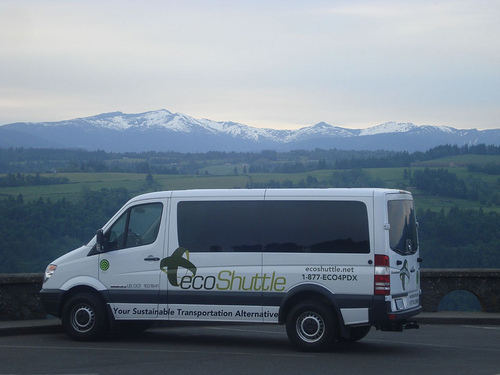
So you’re running your Sprinter RV on biodiesel already, just like Portland’s EcoShuttle? In October I posted about biodiesel Sprinters, and the advantages of biodiesel over conventional diesel fuel: better lubricity, higher cetane ratings, and a higher flash point. Some readers commented on two relevant issues:
Test biodiesel fuel before you put it into your Sprinter – Sprinters use high-pressure fuel systems and are very sensitive to fuel quality. Not only should you test biodiesel before you use it, but be aware that you may need different tests to check the quality of commercial biodiesel and homebrewed diesel. This from a Boulder reader about locally-available Blue Sun B100 biodiesel:
“I would highly recommend that anyone burning biodiesel perform the following two very simple tests before filling your tank. The first one is a test for soap and other impurities – take a small transparent bottle of some kind and add some of the sample of fuel. Add roughly the same amount of water and shake vigorously… the biodiesel and water should FULLY separate within 30 seconds AND the water should appear clear (Blue Sun fails this test impressively.) The second test is a test for unconverted WVO and other contaminants, it is well known as the 27/3 test. Take 27ml of methanol (at room temperature) and place it in a test tube (preferably with a conical pin point bottom), add 3ml of your biodiesel sample and mix vigorously. Now, if you examine the pinpoint bottom of your conical test tube – you should not see anything. The biodiesel should completely dissolve in the methanol. If after time, something collects at the bottom – you have a conversion issue… Surprising to me Blue Sun fails both.”
I asked Blue Sun’s marketing manager, Steve Bond, to comment on these test results. Here is his reply:
“Our B100 is treated with our proprietary DTX™ additive that manages moisture in the distribution stream and vehicle. The additive will interfere with a water wash test. Both our B100 and lower level blends (e.g. B20) contain the DTX™ additive…We are confident there are not soaps in the biodiesel, as we have industry leading quality control protocols that are strictly implemented. We test each batch of fuel at an independent, qualified lab (Hauser Labs in Boulder, CO). This same fuel is used by the City & County of Denver (since 2004) in all their diesel fleet vehicles, without incident. Anything less than this level of quality control would not meet the protocols Blue Sun has established to assure our customers run the best fuel available.”
Regarding the second test, which tests for unconverted feedstock oils and contaminants, he notes:
“We have stringent tests for contaminants that even the ASTM standard falls short on. Unconverted feedstock oils are identifiable via remaining triglycerides in the B100. Partially converted oils are identifiable via mono or diglycerides in the finished fuel. The ASTM standard D6751 does not include specifications for maximum levels of mono- di- or tri-glycerides. Blue Sun’s proprietary B100 specification includes these, plus a maximum allowable level of free glycerin. We test for these using a gas chromatograph test (GC-MS test). This tests for all of these plus free glycerin. Additionally, we run a cold soak filtration test that is more stringent than either ASTM or EN biodiesel specifications, which measures other contaminants by percent volume. We run these test on each batch of fuel that comes into our Denver facility and only fuel that passes the tests continues to our distributors.”
It’s possible that what Steve isn’t saying is that distributors can have their own issues that contribute to fuel quality, including dirty tanks and pumping equipment.
If you are using a biodiesel blend higher than B20, you will need to change your Sprinter’s fuel lines – Biodiesel is a “drop-in” renewable fuel, in the sense that you shouldn’t need modifications to your Sprinter to run it, as you would if you wanted to run vegetable oil. However, this is not quite accurate if you are running biodiesel blends which contain over 20% biodiesel. Colorado Al, a user on the Sprinter-Forum, comments: “If you use biodiesel you need to upgrade your fuel lines to fluoroelastomer lined hose. Stock unlined nitrile hose will breakdown and start leaking. I’m talking about both homebrew bio-diesel and commercially available. With blends up to 20%, you shouldn’t see any problem with the lines you have. If you’re using blends over 20%, and especially if you use B99 or B100 your lines will age prematurely. They will get soft and tacky and eventually you’ll have a pretty bad leak. Also the hose material will leech into the fuel.” Colorado Al notes that SAE J30R9 fluoroelastomer lined 3/8″ hose is one of the compatible fuel line types for a Sprinter running on biodiesel. GreaseWorks offers Viton hose for fuel lines, and links to a fluoroelastomer fuel line report posted on some longer-term use studies.
Of course, I wouldn’t tell you to run any blend higher than B5 biodiesel in your Sprinter, since that is above the official Mercedes recommendation – but some people do!
What about you? Want to run your Sprinter RV on biodiesel? Have experience running a biodiesel Sprinter already? Is a biodiesel Sprinter RV in your near future? Comment and let us know.




Comments on this entry are closed.